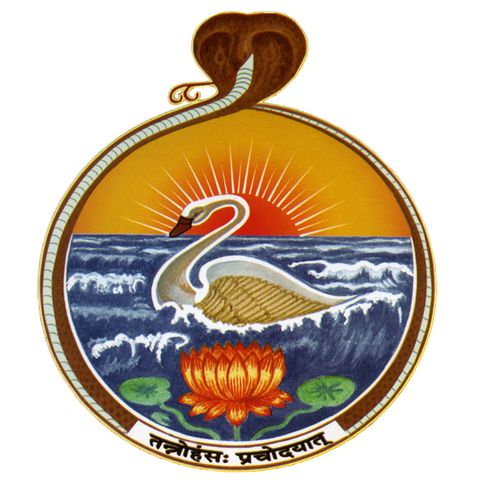Vivekachudamani 15 - Atman – The Eternal Witness Beyond The Five Sheaths | Swami Tattwamayananda

Scarica e ascolta ovunque
Scarica i tuoi episodi preferiti e goditi l'ascolto, ovunque tu sia! Iscriviti o accedi ora per ascoltare offline.
Descrizione
Verses: 124, 125, 154, 165, 167 - This class was given by Swami Tattwamayananda at Stanford University on October 20, 2019. The lecture was hosted by the Stanford Hindu Students...
mostra di più- This class was given by Swami Tattwamayananda at Stanford University on October 20, 2019. The lecture was hosted by the Stanford Hindu Students Association.
- This class focuses on the nature of Absolute Reality, knowing which one gets liberated from the continuous cycle of birth and death
-Everything in the world is composed of two categories of elements. The first category is the permanent, unchanging, Absolute Reality that is beyond name and form. The second category belongs to phenomenal things and is composed of name and form.
-The Real “I” is the subject and eternal witness.
-Absolute Reality is all-pervading as Asti, Bhāti and Priyam, which are three approximate descriptions of the indescribable. Everything has a basic element of existence (Asti), everything is cognizable through effulgence (Bhāti), and has the essential nature of bliss (Priyam).
-Names and forms are innumerable and diverse.
-Atman is present in all three states of awareness – waking, dream and deep sleep states. Since it is present in all three states, it is not exclusive to any state, it is distinct from any state and it transcends all three states.
-Buddha took the principles of Mandukya Upanishad, and gave a long profound discourse on remaining in a state of permanent awareness and witness-ship.
-When we can be identified with awareness, with our own Transcendental Spiritual Reality, we will not feel tired even while working with the body, mind and intellect.
-To be a witness to an activity, two criteria have to be satisfied: (1) One has to be present at the activity (2) One cannot be a participant in the activity.
-“I” is interpreted differently depending on the context in which it is used. When we say “I am feeling pain, or I am happy” the association of “I” is to the body or mind. When we say “My mind or My head”, the association of “I” is to a higher entity that is distinct from the body and mind.
-When we witness a tragic drama, it purifies our emotions. Some of the greatest creative works are tragedies as they penetrate deep into the human mind.
-The concept of free will does not apply to witness. When witnessing, we are not under the control of anything.
-The psychology of relaxation is based on the principle of dissociation. Story of Gotami is discussed, who felt pain at the loss of her son. Buddha asked her to get mustard seeds from a household where no one had ever died. She came back empty-handed and realized that death was common to all. Realizing that her problem was universally shared, helped her dissociate from the pain of losing her son.
-Even while identified with the state of the witness, there is motivation to do karma, because we cannot keep quiet mentally & physically even for a split second. Our own natural tendency will prompt us to do things – if we do good actions, it will generate spiritual energy. For the most evolved spiritual individual, it is his natural tendency to do good to others.
-Another way of explaining Atman is that it is different, distinct, beyond the five sheaths and transcends them all. The five sheaths are: Annamaya Kosha, Prāṇamaya Kosha, Manomaya Kosha, Vijñānamaya Kosha and ānandamaya Kosha. Aham is present in all five sheaths.
-The Annamaya Kosha is the outermost sheath. It comes from matter and food, is endowed with Prāṇa, and consists of skin, flesh, blood, fat, marrow and bones. This cannot be Atman.
-Our spiritual journey starts at the Annamaya Kosha. Ramana Maharshi’s spiritual journey started when he experienced the loss of his father and he understood the perishable nature of the body. Questions around the mystery of death have helped human civilization evolve.
-Prāṇamaya Kosha is changing/moving all the time. It itself does not have effulgence and borrows it from another source. It is spread out all over the physical body. This cannot be Atman, which is independent, steady, unchanging and the nature of effulgence.
-Manomaya Kosha is composed of the five senses of perception and the mind. The five senses of perception are touch, vision, smell, taste and hearing. This also cannot be Atman.
-The ānanda of sat-chit-ānanda, the Absolute Reality is not the same as the ānandamaya Kosha. The ānanda-svarūpa means “its very nature is bliss”; ānandamaya means “there is an abundance of bliss”.
-Any kind of spiritual endeavor brings ānanda. People go on pilgrimage to feel this ānanda. The first sign of a devotee of God is that he has inner serenity and joy.
-Many mystics experienced obstacles and suffering. However, their inner contentment enabled them to withstand these sufferings. Without facing obstacles and learning to withstand these obstacles, one cannot make spiritual progress.
-Absolute Bliss cannot be explained at the empirical level. When we start our spiritual journey, its reflection shows up as inner contentment.
-Intellectual understanding of being the witness helps in spiritual progress. However, one should not start the journey by practicing being the witness.
Informazioni
| Autore | Vedanta Society, San Francisco |
| Organizzazione | Vedanta Society, San Francisco |
| Sito | - |
| Tag |
Copyright 2024 - Spreaker Inc. an iHeartMedia Company

Commenti